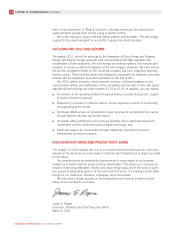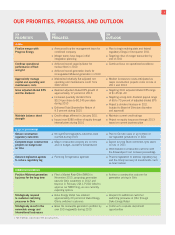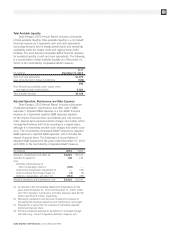Duke Energy 2010 Annual Report Download - page 22
Download and view the complete annual report
Please find page 22 of the 2010 Duke Energy annual report below. You can navigate through the pages in the report by either clicking on the pages listed below, or by using the keyword search tool below to find specific information within the annual report.
DUKE ENERGY CORPORATION / 2010 ANNUAL REPORT
20 NON-GAAP FINANCIAL MEASURES (CONTINUED)
The following is a reconciliation of adjusted segment EBIT for the years ended December 31, 2010 and 2009, to the most
directly comparable GAAP measure:
For the Year Ended December 31, 2010
Economic
Adjusted Goodwill & Hedges Reported
Segment Other Asset (Mark-to- Segment
(In millions) EBIT Impairments Market) EBIT
U.S. Franchised Electric & Gas $2,966 $ — $— $2,966
Commercial Power 398 (660) 33 (229)
International Energy 486 — — 486
Total 2010 reportable segment EBIT $3,850 $(660) $33 $3,223
For the Year Ended December 31, 2009
Economic
Adjusted International Goodwill & Hedges Reported
Segment Transmission Other Asset (Mark-to- Segment
(In millions) EBIT Adjustment Impairments Market) EBIT
U.S. Franchised Electric & Gas $2,321 $ — $ — $ — $2,321
Commercial Power 500 — (413) (60) 27
International Energy 409 (26) (18) — 365
Total 2009 reportable segment EBIT $3,230 $(26) $(431) $(60) $2,713
Adjusted Earnings per Share Accretion in Year One
of Merger with Progress Energy
Duke Energy’s 2010 Annual Report includes a reference
to Duke Energy’s assumption that the merger transaction is
anticipated to be accretive in the first year after closing, based
upon adjusted diluted EPS.
This accretion assumption is a non-GAAP financial measure
as it is based upon diluted EPS from continuing operations
attributable to Duke Energy Corporation shareholders, adjusted
for the per-share impact of special items and the mark-to-market
impacts of economic hedges in the Commercial Power segment
(as discussed above under “Adjusted Diluted Earnings per Share
(‘EPS’)”). The most directly comparable GAAP measure for
adjusted diluted EPS is reported diluted EPS from continuing
operations attributable to Duke Energy Corporation common
shareholders, which includes the impact of special items
(including costs-to-achieve the merger) and the mark-to-market
impacts of economic hedges in the Commercial Power segment.
On a reported diluted EPS basis, this transaction is not
anticipated to be accretive due to the level of costs-to-achieve
the merger. Due to the forward-looking nature of this non-GAAP
financial measure for future periods, information to reconcile
it to the most directly comparable GAAP financial measure is
not available at this time, as management is unable to project
special items or mark-to-market adjustments for future periods.
Dividend Payout Ratio
Duke Energy’s 2010 Annual Report includes a discussion
of Duke Energy’s anticipated long-term dividend payout ratio
of 65-70% based upon adjusted diluted EPS. This payout ratio
is a non-GAAP financial measure as it is based upon forecasted
diluted EPS from continuing operations attributable to Duke
Energy Corporation shareholders, adjusted for the per-share
impact of special items and the mark-to-market impacts of
economic hedges in the Commercial Power segment (as
discussed above under “Adjusted Diluted Earnings Per Share
(‘EPS’)”). The most directly comparable GAAP measure for
adjusted diluted EPS is reported diluted EPS from continuing
operations attributable to Duke Energy Corporation common
shareholders, which includes the impact of special items
and the mark-to-market impacts of economic hedges in
the Commercial Power segment. Due to the forward-looking
nature of this non-GAAP financial measure for future periods,
information to reconcile it to the most directly comparable
GAAP financial measure is not available at this time, as
management is unable to project special items or mark-to-
market adjustments for future periods.

















